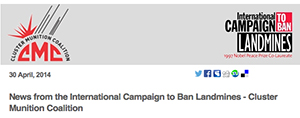A History of Landmines
Precursors of the weapon are said to have first been used in the American Civil War in the 1800s. But antipersonnel mines were first used on a wide scale in World War II. Since then they have been used in many conflicts, including in the Vietnam War, the Korean War, and the first Gulf War. During the Cold War, many states laid long stretches of landmines along borders.
Today, the weapon is still being used in a handful of conflicts.
Antipersonnel mines were initially developed to protect antitank mines and stop them being removed by enemy soldiers. They were used defensively, to protect strategic areas such as borders, camps, or important bridges and to restrict the movement of opposing forces.
A key characteristic of the weapon is that it is designed to maim rather than kill an enemy soldier. This follows the "logic" that more resources are taken up caring for an injured soldier on the battlefield than dealing with a soldier who has been killed.
Over time, antipersonnel landmines began to be deployed on a wider scale, often in internal conflicts and specifically targeting civilians. They were used to terrorize communities, deny access to farming land, and restrict population movement.
The practice of marking and mapping minefields was no longer followed strictly. Indeed, many combatants no longer laid mines in a contained area, but placed them around a variety of strategic areas without any specific pattern. As a result, civilians, peacekeepers, aid workers, and soldiers alike had no way of knowing if they entered a mined area. Rain, floods, and other factors have also shifted minefields over time. So without clear records, and with the impacts of weather and time, clearing up the mess after a conflict became even harder.
Developments
Technological developments saw the production of systems for delivering mines from the air. These were then used in much larger numbers and mapping and marking became almost impossible.
Also, so-called "smart" mines were developed. These self-destructing and self-deactivating mines are meant to destroy or deactivate themselves after a designated period of time. However, like "dumb" or long-lived mines, this so-called "smart" variety are indiscriminate and inhumane weapons when armed. Also, some may fail to self-destruct or self-deactivate and so may remain live indefinitely. They tend to be dropped by air, often in larger numbers than ground delivered mines, and are not fenced, marked or monitored thus posing the same long-term risk to life and limb, as long-lived mines.
Military intelligence
Over time it also became obvious that antipersonnel mines often harmed the very people they were there to protect: the soldiers. In addition to mounting soldier casualties, there was growing opposition to mine use within military ranks. Some soldiers came to understand that the humanitarian costs far outweigh the limited and questionable military utility of the weapon.
Production
Over 50 countries have produced antipersonnel mines at some time, both for their own stocks and to supply others.
Forty-one states have ceased production of antipersonnel mines, including four that are not party to the Mine Ban Treaty: Egypt, Israel, Nepal, and the US. None of the States Parties to the Mine Ban Treaty produce landmines anymore. Unfortunately, 11 states not party continue to reserve the right to do so: China, Cuba, India, Iran, Myanmar, North Korea, South Korea, Pakistan, Russia, Singapore, and Vietnam. Actual production may be ongoing in only four of them: India, Myanmar, Pakistan, and South Korea.
At the same time some non-state armed groups or rebel groups in various countries produce antipersonnel mines, mostly of the improvised variety.
For the latest updates see Landmine Monitor.



